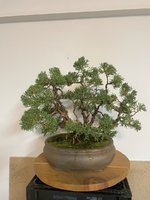gjones_42
Yamadori
A very, very delayed progression update on this shimpaku clump, with details on the work... Photos are from earlier this month; of course I failed to take a pic after the major pruning...
After a few months of pondering last Winter, decided to forgo a repot and focus on restyling this tree. The roots seemed in good shape based on overall vigor of the tree and good percolation into the media, and I saw a bigger need to start foliar work than "peak under the hood"... In Feb/March '23 I worked through each trunk by bending the branches by hand and seeing which got to a place I desired, and then getting rid of the branches that did not. Since everything was crowding upwards, I wired each trunk/primary branch as I pruned so I could clear space and start to build out a design. It was challenging and took a few weeks, but this approach worked out really well for me.
Over all I removed about 50% of the canopy this way and wired out as many branches as I could. I did not wire all branches, and in fact very little detial wiring, as this was my first wire project and I knocked off some foliage when I tried to go to the ends. I also definitely tore some small primary branches while trying to wire, so I stopped while it felt like I was ahead. I purposefully did not clean up the pads on the remaining foliage given how much I had removed overall. I was nervous about over working and killing the tree, so I kept it in mostly sunny spot with noon shade during the year. It pushed some new growth, but not a ton, and was overall very healthy. I gradually added a bit more detail wire to better position the branches in the fall.
In general I think the tree responded well to this level of work, based on some positive growth and a lack of die back. There is still a lot of foliage to be removed, probably 50% of what still remains, but the overall shape is coming through. Very hard to see the trunk lines in these pictures, but they are developing. In the coming weeks I will clean and thin the pads and wire or remove a couple more branches where I wasn't sure what to do.
After a few months of pondering last Winter, decided to forgo a repot and focus on restyling this tree. The roots seemed in good shape based on overall vigor of the tree and good percolation into the media, and I saw a bigger need to start foliar work than "peak under the hood"... In Feb/March '23 I worked through each trunk by bending the branches by hand and seeing which got to a place I desired, and then getting rid of the branches that did not. Since everything was crowding upwards, I wired each trunk/primary branch as I pruned so I could clear space and start to build out a design. It was challenging and took a few weeks, but this approach worked out really well for me.
Over all I removed about 50% of the canopy this way and wired out as many branches as I could. I did not wire all branches, and in fact very little detial wiring, as this was my first wire project and I knocked off some foliage when I tried to go to the ends. I also definitely tore some small primary branches while trying to wire, so I stopped while it felt like I was ahead. I purposefully did not clean up the pads on the remaining foliage given how much I had removed overall. I was nervous about over working and killing the tree, so I kept it in mostly sunny spot with noon shade during the year. It pushed some new growth, but not a ton, and was overall very healthy. I gradually added a bit more detail wire to better position the branches in the fall.
In general I think the tree responded well to this level of work, based on some positive growth and a lack of die back. There is still a lot of foliage to be removed, probably 50% of what still remains, but the overall shape is coming through. Very hard to see the trunk lines in these pictures, but they are developing. In the coming weeks I will clean and thin the pads and wire or remove a couple more branches where I wasn't sure what to do.









